Update To: A Wide-Notch Comb Filter
This blog presents alternatives to the wide-notch comb filter described in Reference [1]. That comb filter, which for notational reasons I now call a 2-RRS wide notch comb filter, is shown in Figure 1. I use the "2-RRS" moniker because the comb filter uses two recursive running sum (RRS) networks.
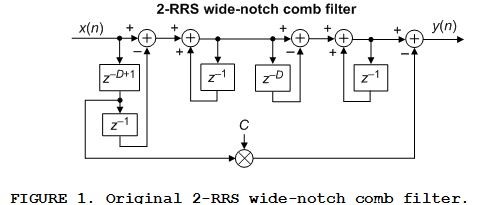
The z-domain transfer function of the 2-RRS wide-notch comb filter, H2-RRS(z), is:

Encouraged by hirnprinz's Nov. 26th Comment to my Reference [1] blog, I began to experiment with various modifications to the above 2-RRS wide-notch comb filter.
The most noteworthy thing I learned from my experimentation is shown in Figure 2. If we cascade a single recursive running sum (RRS) network to the Figure 1 comb filter, as shown in Figure 2(a), we place frequency magnitude nulls right smack in the middle of the original Figure 1 comb filter's notches. The frequency magnitude response of the Figure 2(a) Enhanced wide-notch comb filter is shown as the solid curve in Figure 2(b).
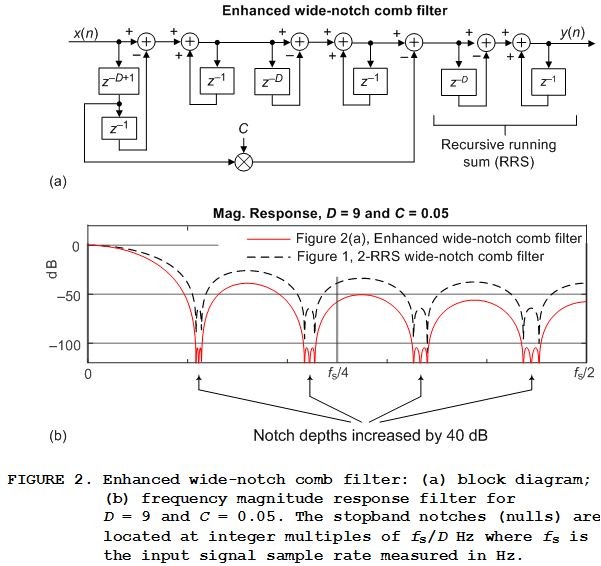
So, at the expense of an additional storage register, a D-length delay line, and two additions per output sample, we have significantly increased the notch attenuation depths.
The z-domain transfer function of the Figure 2(a) Enhanced wide-notch comb filter, HEWNC(z), is the product of H2-RRS(z) and the transfer function of an RRS network; that is:

This comb filter is linear-phase and its group delay is:
Enhanced wide-notch comb filter group delay = 3(D-1)/2 samples,
which is always an integer number of samples when D is an odd integer.
In MATLAB code we define the notch width control parameter C and the value of integer D, and use the following to define HEWNC(z)'s 'B' numerator coefficients and its 'A' denominator coefficients:
B = [1, zeros(1,D-2), -C, (2*C-3), -C, zeros(1,D-3), C, (3-2*C), C, zeros(1,D-2), -1];
A = [1, -3, 3, -1];
A Unity-Gain Enhanced Wide-Notch Comb Filter
The DC gain (gain at zero Hz) of the Figure 2(a) Enhanced wide-notch comb filter is:
HEWNC DC gain = D3—DC. (3)
Appendix B shows how to implement a unity-gain Enhanced wide-notch comb filter.
Other Variations of the 2-RRS Wide-Notch Comb Filter
Fortunately I was able to avoid "Death by Algebra" and successfully investigate other variations of the original 2-RRS wide-notch comb filter.
Those other comb filters, having wider comb notches than the 2-RRS wide-notch comb filter, are described in Appendix A.
Conclusion
I've described four alternatives to the wide-notch comb filter presented in Reference [1]; most notably the deep-notch Enhanced wide-notch comb filter shown in Figure 2(a). (Snippets of MATLAB code were provided.) In addition, Appendix B shows how to implement a unity passband gain version of the Enhanced wide-notch comb filter.

References
[1] R. Lyons, "A Wide-Notch Comb Filter", dsprelated.com Blogs, Nov. 24, 2019, Available online:
https://www.dsprelated.com/showarticle/1308.php
Appendix A: Variations of the Wide-Notch Comb Filter
This appendix describes three additional variations to the Figure 1 original 2-RRS wide-notch comb filter. Here we present the block diagrams, the z-domain transfer functions, and MATLAB code needed to model the three alternative wide-notch comb filters.
3-RRS Wide-Notch Comb Filter
Another comb filter variation I investigated is the linear-phase 3-RRS wide-notch comb filter shown in Figure A-1.
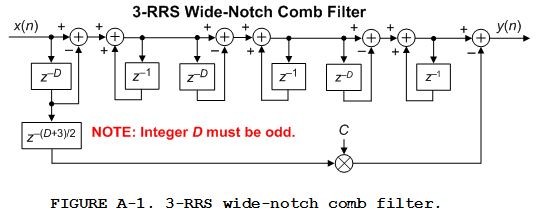
The z-domain transfer functions of the 3-RRS wide-notch comb filter is:

Note that this filter is only stable when D is an odd integer. The group delay of the 3-RRS wide-notch comb filter is:
3-RRS wide-notch comb filter group delay = 3(D-1)/2 samples.
In MATLAB code we define the notch width control parameter C and the value of integer D, and use the following to define H3-RRS(z)'s 'B' numerator coefficients and its 'A' denominator coefficients:
B = [1, zeros(1,D-1), -3, zeros(1,(D-5)/2), -C, 3*C, ...
-3*C, C, zeros(1,(D-5)/2), 3, zeros(1,D-1), -1];
A = [1, -3, 3, -1];
4-RRS Wide-Notch Comb Filter
The next comb filter variation I explored is the linear-phase 4-RRS wide-notch comb filter shown in Figure A-2.
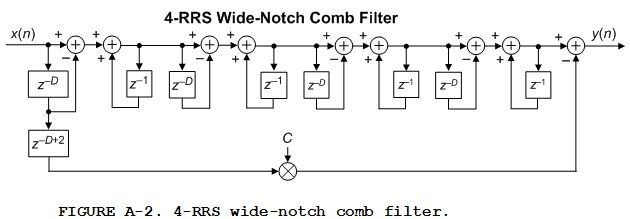
The z-domain transfer functions of the 4-RRS wide-notch comb filter is:

The group delay of the 4-RRS wide-notch comb filter is:
4-RRS wide-notch comb filter group delay = 2(D-1) samples.
In MATLAB code we define the notch width control parameter C and the value of integer D, and use the following to define H4-RRS(z)'s 'B' numerator coefficients and its 'A' denominator coefficients:
B = [1, zeros(1,D-1), -4, zeros(1,D-3), -C, 4*C, 6*(1-C), 4*C, ...
-C, zeros(1,D-3), -4, zeros(1,D-1), 1];
A = [1, -4, 6, -4, 1];
Dual 2-RRS Wide-Notch Comb Filter
The last comb filter variation is the linear-phase Dual 2-RRS wide-notch comb filter formed by cascading a pair of 2-RRS wide-notch comb filters as shown in Figure A-3.

The z-domain transfer function of the Dual 2-RRS wide-notch comb filter is a messy algebraic expression. To model this filter in software we can obtain its rational polynomial transfer function, HD2-RRS(z), by convolving Eq. (1) with itself as:

The group delay of the Dual wide-notch-notch comb filter is:
Dual 2-RRS wide-notch comb filter group delay = 2(D-1) samples.
In MATLAB code we define the notch width control parameter C and the value of integer D, and use the following to define HD2-RRS(z)'s 'B' numerator coefficients and its 'A' denominator coefficients:
B = [1, zeros(1,D-2), -C, -2*(1-C), -C, zeros(1,D-2), 1];
A = [1, -2, 1];
B = conv(B, B);
A = conv(A, A);
Figure A-4 shows a comparison of the above three comb filters' frequency magnitude responses versus the magnitude response of the original 2-RRS wide-notch comb filter when D = 9 and C = 0.05.
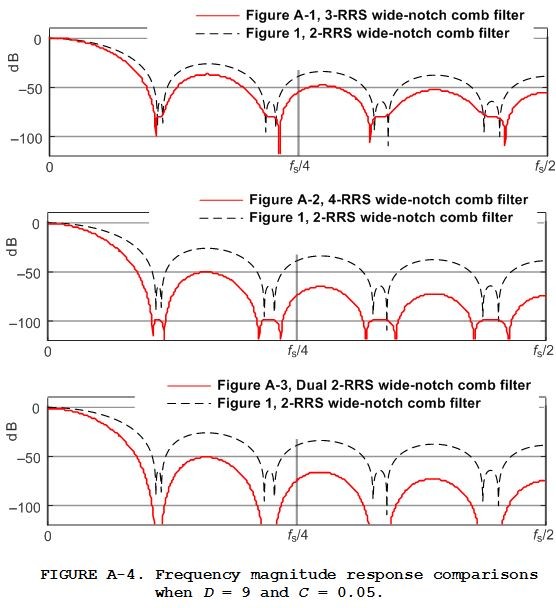
Appendix B: Unity Gain Enhanced Wide-Notch Comb Filter
The simplest method to implement a unity gain (at zero Hz) Enhanced wide-notch comb filter is shown in Figure B-1(a). There we merely scaled the comb filter's output sequence by the reciprocal of the filter's passband gain of D3—DC.

In fixed-point implementations, to reduce the necessary word width of the various accumulators (adders) and two of the z‑D delay lines, the distributed scaling methods in Figures B-1(b) and B-1(c) can be used. Equation (B-1) gives the transfer function for all the comb filters in Figure B-1:

- Comments
- Write a Comment Select to add a comment
To post reply to a comment, click on the 'reply' button attached to each comment. To post a new comment (not a reply to a comment) check out the 'Write a Comment' tab at the top of the comments.
Please login (on the right) if you already have an account on this platform.
Otherwise, please use this form to register (free) an join one of the largest online community for Electrical/Embedded/DSP/FPGA/ML engineers:


























